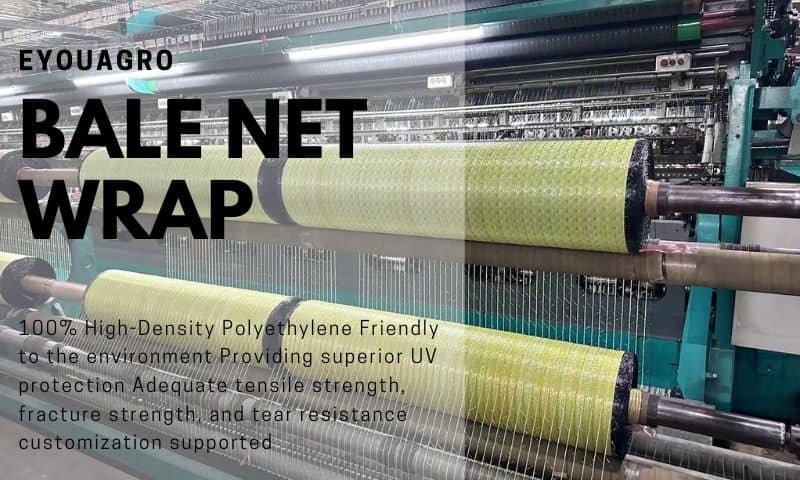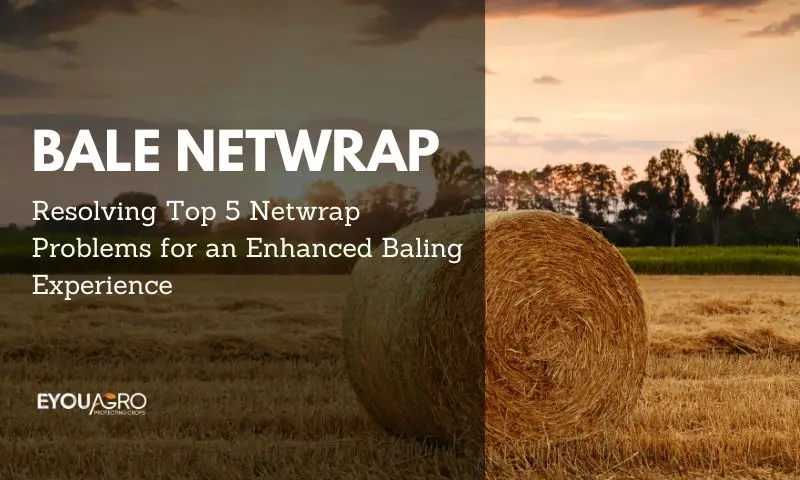Introduction
In the world of hay baling, the correct usage and application of netwrap can spell the difference between efficiency and wasted effort.
When appropriately used, bale netwrap can protect your hay bales, maintain their shape, and ensure their quality.
However, specific issues can arise in the baling process, hindering optimal usage of netwrap.
This blog post addresses the top five netwrap problems and provides practical solutions to enhance your baling experience.
Problem 1: Uneven Bale Surface
When it comes to bale netwrap, achieving a uniform and flat surface across the bale is crucial. Bales with uneven shapes can increase pressure on the netwrap, compromising its performance and durability. To address this, make sure that the feed into the baler is even and at a steady rate.
This will result in a uniformly shaped bale that supports the netwrap properly, thereby enhancing its effectiveness and durability.
Solution
Regulate the feed into the baler to be consistent and steady to create a uniform and flat bale surface.
A uniform bale shape correctly supports the netwrap, enhancing its functionality and lifespan. Regular inspection and maintenance of feeding equipment can also help to ensure consistency.
Problem2: Netwrap Trapped Inside the Bale
Applying netwrap correctly is integral to successful baling. When the netwrap is fed into the baler while the crop is still being gathered, some of the netwrap can be trapped inside the bale rather than covering the surface as intended.
This scenario can lead to several issues:

Increased Bale Diameter
The netwrap inside the bale can cause an undesired expansion in the bale’s diameter.
This hampers transportation and storage and puts undue stress on the netwrap, affecting its durability.
Potential Netwrap Damage
During bale ejection, the netwrap trapped inside the bale may become damaged. This compromises the effectiveness of the netwrap, leading to poor bale shape and increased exposure to environmental factors.
Insufficient Bale Security
With the netwrap partly inside the bale, the external coverage is incomplete, which leads to inadequate bale securing.
This can cause instability during handling and transportation, increasing the risk of bale damage.
Risk of Bale Bursting
With fewer layers of netwrap on the intended surface of the bale, the netwrap may struggle to withstand the pressure exerted by the hay or straw inside.
This increases the likelihood of bales bursting open, which could lead to significant crop loss.
Solution
To prevent these issues, it’s essential to ensure that the crop-gathering process is complete before introducing the netwrap into the baler.
Regular checks of your equipment and careful monitoring of the baling process can help prevent this problem, ensuring the integrity of your bales and the effective use of your netwrap.
Problem 3: Oversized and Dense Bale
A huge and densely packed bale can lead to multiple issues, including getting stuck inside the baler.
Baling settings that don’t match the crop volume and type can result in excessively large and densely packed bales, causing difficulties in bale ejection and potential damage to the netwrap.

Solution
Adjust the baler settings to correspond with the volume and type of crop being baled. This ensures optimal bale size and density, facilitates easy ejection from the baler, and prevents potential damage to the netwrap. Regular training for operators on baler settings can enhance this adjustment process.
Problem 4: Insufficiently Smooth Chamber Side Walls
The efficiency of the baling process largely depends on the condition of the baler itself. If the chamber side walls aren’t smooth, the bale may have difficulty rotating freely, causing complications during baling. Regular maintenance and cleaning of the baler chamber can help maintain a smooth surface and ensure that the bales rotate properly for an evenly wrapped product.
Solution
Regular maintenance and cleaning of the baler chamber ensure a smooth surface for bale rotation and even wrapping.
Problem 5: Incorrect Baler Alignment
Incorrect alignment of the baler with the tractor can hinder the easy ejection of the bale, creating obstructions and challenges. Ensure the baler is hitched correctly and aligned with the tractor according to the manufacturer’s instructions.
Furthermore, remember to promptly release the bale from the baler once the tailgate is opened. This prevents the spinning rollers in the chamber from damaging the netwrap.
Solutions
Decrease RPM or disengage the PTO (Power Take-Off)
To avoid damaging the netwrap, consider decreasing the RPM or disengaging the PTO of the baler. This action will reduce the speed of the spinning rollers, subsequently minimizing the friction between the rollers and the bale surface.
As a result, the potential harm to the netwrap due to this unwanted friction is alleviated. This solution is particularly relevant when working with balers equipped with rollers in the bale chamber, regardless of the type of netwrap used.

Ensure Proper Alignment
Correct alignment between the baler and the tractor is pivotal for a smooth baling. Always refer to the manufacturer’s instructions to properly hitch and align the baler with the tractor.
This step facilitates smoother bale ejection from the baler, ensuring that the bale is released promptly and without unnecessary contact with the rollers, thus preserving the integrity of the netwrap.
By tackling the problem of incorrect baler alignment head-on, you can improve your baling process and further protect your netwrap from potential damage.
Through this attention to detail, you’ll enhance your baling efficiency and the quality of your bales.
FAQs
Q: What can I do if my bale surface is uneven?
A: You should ensure that the feed into the baler is even and at a steady rate. This will result in a uniformly shaped bale that supports the netwrap properly, thereby enhancing its effectiveness and durability.
Q: How can I prevent netwrap from being trapped inside the bale?
A: Make sure the crop gathering process is complete before introducing the netwrap into the baler. Regular equipment checks and careful monitoring of the baling process can help prevent this issue.
Q: What should I do if my bale is oversized and dense?
A: Adjust the baler settings to match the volume and type of baled crop. This will ensure that the resulting bales are optimal size and density, facilitating easy ejection from the baler.
Q: How can I keep my baler’s chamber side walls smooth?
A: Regular maintenance and cleaning of the baler chamber can help maintain a smooth surface and ensure that the bales rotate properly for an evenly wrapped product.
Q: What if my baler is not properly aligned with the tractor?
A: Always ensure the baler is hitched correctly and aligned with the tractor according to the manufacturer’s instructions. This will facilitate smoother bale ejection and preserve the integrity of the netwrap.

Conclusion
Baling is an art as much as it is a science. By identifying potential issues and implementing the solutions, you can improve your baling efficiency, protect your investment in netwrap, and produce high-quality hay bales. For an enhanced baling experience, consider using our premium netwrap.
Unlock your baling potential with EyouAgro! Leveraging years of production experience, we deliver top-quality netwrap solutions to enhance efficiency and secure superior hay bale quality.
Our team has developed this high-quality product to withstand the challenges of hay baling while maximizing efficiency.
Contact us today to learn more about our netwrap products and how they can benefit your hay production.









